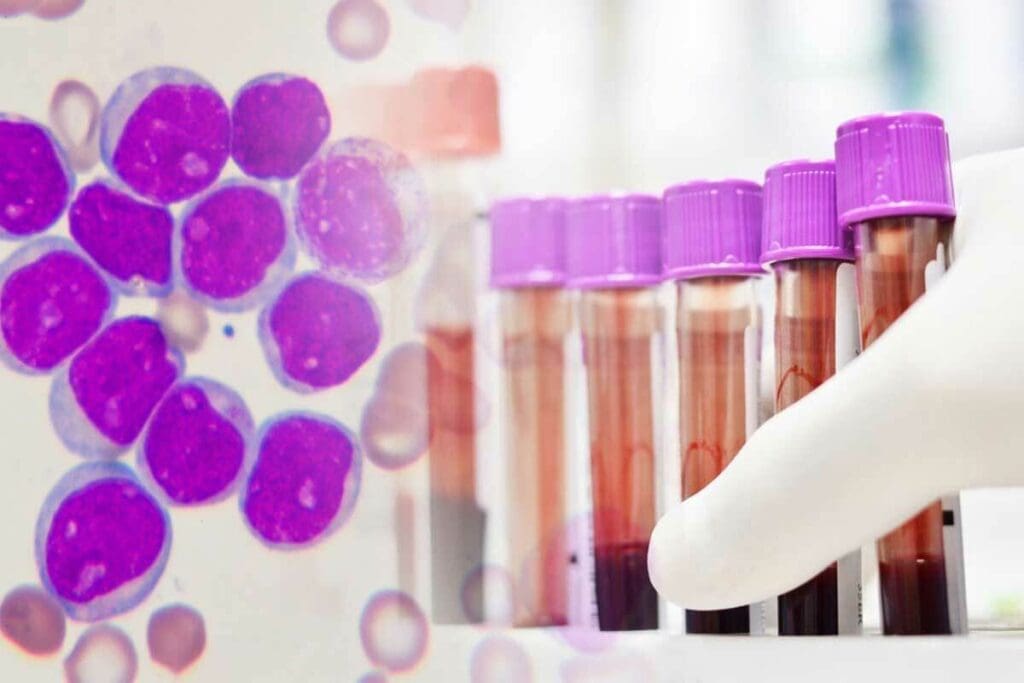Last Updated on November 20, 2025 by Ugurkan Demir

Leukemia treatment is always getting better to help more patients. At Liv Hospital, we focus on giving the best care. We use new treatments and methods to help those with leukemia. Find out how long chemo treatment for leukemia lasts, its phases, and what to expect during each recovery stage. It’s important to know about the different leukemia drugs out there. We aim to give care that fits you perfectly. We consider the type of leukemia you have and your health.
Choosing the right treatment depends on many things. This includes the type of leukemia, how old you are, and your health. We look at all the leukemia medications and treatments. This includes chemotherapy and targeted therapies, to give you the best care.

Our understanding of leukemia is growing, leading to better treatments. Today, we have many ways to fight leukemia, from old-school chemotherapy to new, targeted therapies.
Leukemia isn’t just one disease; it’s a group of cancers affecting blood and bone marrow. The type of leukemia matters a lot for choosing the right treatment. The main types are:
Choosing a treatment for leukemia depends on several things. These include the leukemia type, the patient’s age, and their health.
Leukemia treatment has changed a lot over time. This change comes from new research and technology. While chemotherapy is key, targeted therapies are becoming more popular. They work better and have fewer side effects.
Some big changes in leukemia treatment include:
These new treatments have brought hope and better results for leukemia patients. As research keeps moving forward, we’ll see even more progress. This will include more personalized and targeted treatments.

Targeted therapies are key in fighting leukemia. They focus on specific problems in cancer cells. This makes them more precise than old treatments.
Leukemia drugs aim at different parts of cancer cell growth. Tyrosine kinase inhibitors (TKIs) stop certain enzymes that help cancer cells grow. Imatinib (Gleevec) is a famous TKI that changed CML treatment by targeting BCR-ABL tyrosine kinase.
FLT3 inhibitors are used for AML. They target the FLT3 gene mutation, common in AML and linked to bad outcomes.
| Targeted Therapy | Mechanism of Action | Leukemia Type |
| Imatinib (Gleevec) | BCR-ABL tyrosine kinase inhibition | CML |
| FLT3 inhibitors (e.g., Gilteritinib) | FLT3 gene mutation inhibition | AML |
| Venetoclax (Venclexta) | BCL-2 inhibition | CLL, AML |
Some drugs boost the body’s fight against leukemia cells. Monoclonal antibodies are a type of immunotherapy. They target specific proteins on leukemia cells, making them easier for the immune system to destroy.
Rituximab (Rituxan) is used for some B-cell leukemias. It attacks the CD20 protein on B cells, helping to get rid of cancer cells.
Understanding how leukemia drugs work shows the complexity of modern treatments. These drugs, through targeted therapies or boosting the immune system, give hope to leukemia patients.
Traditional chemotherapy drugs are key in fighting leukemia. They have been used a lot and studied well. They are the main part of leukemia treatment plans.
Cytarabine is a big help in treating Acute Myeloid Leukemia (AML). It stops leukemia cells from growing by messing with their DNA.
Cytarabine’s success in AML treatment is proven. It’s a key part of many chemotherapy plans.
Daunorubicin and idarubicin are important in leukemia treatment. They mess with DNA, stopping leukemia cells from living.
These drugs are great at treating AML. They have really helped patients get better.
Vincristine and vinblastine come from the periwinkle plant. They stop cells from dividing by messing with tubulin.
Vincristine is often used for acute lymphoblastic leukemia (ALL). Vinblastine is used in many chemotherapy plans.
Cyclophosphamide and methotrexate are well-known in leukemia treatment. Cyclophosphamide damages DNA, stopping cancer cells from growing.
Methotrexate messes with DNA synthesis, slowing down leukemia cell growth.
Tyrosine kinase inhibitors have changed how we treat leukemia. They offer targeted treatments that have greatly helped patients. These drugs target specific enzymes that control protein activation. They are key in treating chronic myeloid leukemia (CML) and some acute lymphoblastic leukemia (ALL).
Imatinib, known as Gleevec, was the first drug for CML. It targets the BCR-ABL enzyme in CML cells. Imatinib has made CML a manageable disease for many, turning a once deadly illness into a chronic condition. Its success led to more tyrosine kinase inhibitors.
Dasatinib and nilotinib are newer drugs for CML. They are stronger than imatinib and work better against resistant mutations. Both are used as first treatments for CML, showing better results than imatinib for some patients.
Bosutinib and ponatinib are for CML patients who don’t respond to other drugs. Ponatinib is great against the T315I mutation, a tough mutation for other drugs. These drugs offer hope for patients with resistant or advanced disease.
While TKIs have improved leukemia treatment, they have side effects. Common issues include fatigue, nausea, and skin rashes. Serious side effects like heart problems and severe blood issues can also happen. Managing these side effects is key to keeping patients’ quality of life good. This means regular checks, adjusting doses, and supportive care.
Oral leukemia medications have changed how we treat the disease. They let patients take their medicine at home. This makes treatment easier and more convenient.
Looking into oral leukemia meds, we see their good sides and challenges. It’s key to know both to understand their impact on treatment.
Oral leukemia meds, like tablets and pills, have made a big difference. They offer more flexibility and fewer hospital trips. This helps patients live more normally while getting treatment.
These meds target cancer cells like their IV versions. But they’re easier to take at home. This boosts a patient’s life quality.
Oral leukemia meds have many pluses but need careful handling. Good treatment adherence is key for success.
To manage oral leukemia treatment well, patients should:
By using these strategies, patients can get the most from their oral leukemia meds. This improves their treatment journey.
Monoclonal antibodies have changed how we treat leukemia. They target cancer cells directly, protecting healthy cells. This leads to better results for patients.
Rituximab is a key treatment for B-cell leukemias and lymphomas. It attacks the CD20 antigen on B cells. This helps kill cancerous B cells, reducing harm to normal cells.
Obinutuzumab and ofatumumab are newer versions of anti-CD20 antibodies. They work better than rituximab. Obinutuzumab kills cancer cells more effectively. Ofatumumab targets CD20 differently, making it a good alternative.
Blinatumomab is a special antibody that connects T cells to B cells. It does this by binding to CD19 on B cells and CD3 on T cells. This action helps T cells kill B cells, which is key in treating some leukemias.
Gemtuzumab ozogamicin targets CD33 on myeloid cells. It’s used for acute myeloid leukemia (AML). The drug is attached to an antibody, which releases a toxin when it binds to CD33. This kills leukemia cells without harming healthy ones.
These monoclonal antibodies are big steps forward in leukemia treatment. They are more effective and have fewer side effects than traditional chemotherapy.
Leukemia treatment has made a big leap with BCL-2 inhibitors. These drugs make leukemia cells die by inducing programmed cell death. They have shown great results in trials and are changing how we treat leukemia.
Venetoclax, known as Venclexta, is a BCL-2 inhibitor that’s getting a lot of attention. It works by blocking the BCL-2 protein, which helps control cell death. This makes leukemia cells die off.
Venetoclax is really helping patients with chronic lymphocytic leukemia (CLL) and acute myeloid leukemia (AML). It’s shown to work well in patients who didn’t respond to other treatments.
Using venetoclax with other drugs is a smart move to make it work better. This way, doctors can attack leukemia cells more effectively.
New hope is on the horizon for leukemia patients. Innovative treatments are emerging. The medical community is seeing big advancements in targeted therapies.
Revumenib is a new way to treat certain leukemias. It targets the menin-MLL interaction. This drug is promising for patients with specific genetic mutations.
Gilteritinib is a strong inhibitor of FLT3 mutations in AML. It has shown great results in patients with relapsed or refractory FLT3-mutated AML. It offers better survival rates and is safe.
Enasidenib and ivosidenib target IDH1 and IDH2 mutations in AML. These mutations are found in some AML patients. By blocking these mutations, these drugs help differentiate leukemic cells, leading to better outcomes.
The emergence of these drugs shows the progress in understanding leukemia. As research keeps advancing, we can expect even better treatments for patients.
| Drug | Target | Indication |
| Revumenib | Menin-MLL interaction | Specific genetic mutations in leukemia |
| Gilteritinib (Xospata) | FLT3 mutations | Relapsed or refractory FLT3-mutated AML |
| Enasidenib (Idhifa) | IDH2 mutations | Relapsed or refractory AML with IDH2 mutation |
| Ivosidenib (Tibsovo) | IDH1 mutations | Relapsed or refractory AML with IDH1 mutation |
Cellular therapies are changing how we treat leukemia. They use living cells to fight cancer. This is a big step forward in treating leukemia.
CAR T-cell therapy is a new way to fight cancer. It takes T cells from your blood, changes them, and puts them back in. Tisagenlecleucel (Kymriah) is one of these therapies. It works by targeting B cells in leukemia.
This therapy has shown great results. It can lead to high remission rates in B-ALL patients. But, it can also cause side effects like cytokine release syndrome.
Stem cell transplantation replaces bad bone marrow with good one. It’s a cure for many leukemias.
The process uses strong chemotherapy and radiation to clear the bone marrow. Then, healthy stem cells are given. The source of these stem cells depends on the patient’s situation.
| Treatment | CAR T-Cell Therapy | Stem Cell Transplantation |
| Mechanism | Genetically modified T cells target cancer cells | Replaces diseased bone marrow with healthy stem cells |
| Indications | Relapsed/refractory B-ALL, certain lymphomas | Various leukemias, lymphomas, and other hematologic malignancies |
| Side Effects | Cytokine release syndrome, neurotoxicity | Graft-versus-host disease, infections, organ toxicity |
Cellular therapies like CAR T-cell and stem cell transplantation are big steps in leukemia treatment. They offer hope for patients with hard-to-treat disease. They could lead to better outcomes.
Thanks to personalized medicine, finding the right treatment for leukemia is now more precise. Doctors can create treatment plans that match each patient’s unique needs. This approach leads to better results and fewer side effects.
Genetic testing is key in finding the best treatments for leukemia. It helps doctors understand the leukemia cells’ genetic makeup. This information guides them to choose the right treatments.
For example, certain mutations like FLT3 or IDH1/2 suggest the use of gilteritinib or ivosidenib. This ensures patients get the most suitable therapy for their leukemia type.
Keeping an eye on how well treatment works is vital in leukemia care. Regular checks help doctors adjust the treatment plan as needed. This might mean changing medications, adjusting doses, or adding new treatments.
By closely watching how treatment progresses, we can improve patient outcomes. We also reduce the chance of treatment not working well.
Effective monitoring uses various methods, including:
Using these advanced tools, we can offer highly personalized care for leukemia patients. This increases their chances of successful treatment.
Leukemia treatment has made big strides over the years. Now, we have many medicines and therapies to help patients. But, we need to keep researching and innovating to make treatments even better.
New treatments like targeted therapies are showing great promise. These include tyrosine kinase inhibitors and monoclonal antibodies. More research in these areas could make treatments safer and more effective.
But it’s not just about new medicines. We’re also exploring new ways to treat leukemia, like cellular therapies and personalized medicine. These approaches aim to give patients treatments that are just right for them.
We’re dedicated to improving leukemia treatment and supporting patients from around the world. By staying ahead in research, we can make a real difference in people’s lives. This means better health and a higher quality of life for those fighting leukemia.
The most common types of leukemia are Acute Lymphoblastic Leukemia (ALL), Acute Myeloid Leukemia (AML), Chronic Lymphocytic Leukemia (CLL), and Chronic Myeloid Leukemia (CML). Treatments vary depending on the type. They may include chemotherapy, targeted therapies, and cellular therapies.
Leukemia drugs target cancer cell growth and enhance the immune response. They also induce cell death in leukemia cells. This is done by blocking specific proteins or pathways that cancer cells need.
Tyrosine kinase inhibitors are targeted therapies that have greatly improved leukemia treatment. Examples include imatinib, dasatinib, nilotinib, bosutinib, and ponatinib. They are used to treat CML and some cases of ALL.
Oral leukemia medications, like tablets and pills, allow treatment at home. This reduces the need for hospital visits. It can improve quality of life and treatment adherence.
Monoclonal antibodies are proteins designed to target specific cells, including cancer cells. Examples used in leukemia treatment include rituximab, obinutuzumab, ofatumumab, blinatumomab, and gemtuzumab ozogamicin.
Venetoclax is a BCL-2 inhibitor that induces programmed cell death in leukemia cells. It is used to treat certain types of leukemia, including CLL. It is often used in combination with other therapies.
Emerging and innovative leukemia drugs include revumenib, gilteritinib, enasidenib, and ivosidenib. These drugs represent new approaches to treating leukemia. They target specific mutations or pathways.
CAR T-cell therapies, such as tisagenlecleucel, are a form of cellular therapy. They involve modifying a patient’s T-cells to recognize and attack leukemia cells. This approach has shown significant promise in treating certain types of leukemia.
Personalized medicine involves tailoring treatment to the individual based on genetic testing and biomarker-guided treatment selection. This approach can help identify the most effective treatment for a specific patient. It also monitors treatment response.
Genetic testing is critical in leukemia treatment. It helps identify specific mutations or biomarkers that guide treatment selection. This information can help choose targeted therapies or other treatments that are more likely to be effective.
Leukemia medications are managed through a combination of medical supervision, patient education, and adherence strategies. Challenges include managing side effects, ensuring treatment adherence, and adjusting treatment plans as needed.
Stem cell transplantation is a potentially curative treatment for leukemia. It involves replacing a patient’s bone marrow with healthy stem cells. This approach can be used to treat various types of leukemia.
Leukemia treatments have evolved significantly over time. Advances in chemotherapy, targeted therapies, and cellular therapies have improved treatment outcomes and quality of life for patients.
Common side effects of leukemia medications vary depending on the specific treatment. They can include nausea, fatigue, hair loss, and increased risk of infection. Managing these side effects is an important part of leukemia care.
Kayser, S., & Levis, M. J. (2024). Navigating acute myeloid leukemia towards better outcomes. Leukemia Research, 117, 106682. https://www.sciencedirect.com/science/article/pii/S2210803325000041
Subscribe to our e-newsletter to stay informed about the latest innovations in the world of health and exclusive offers!